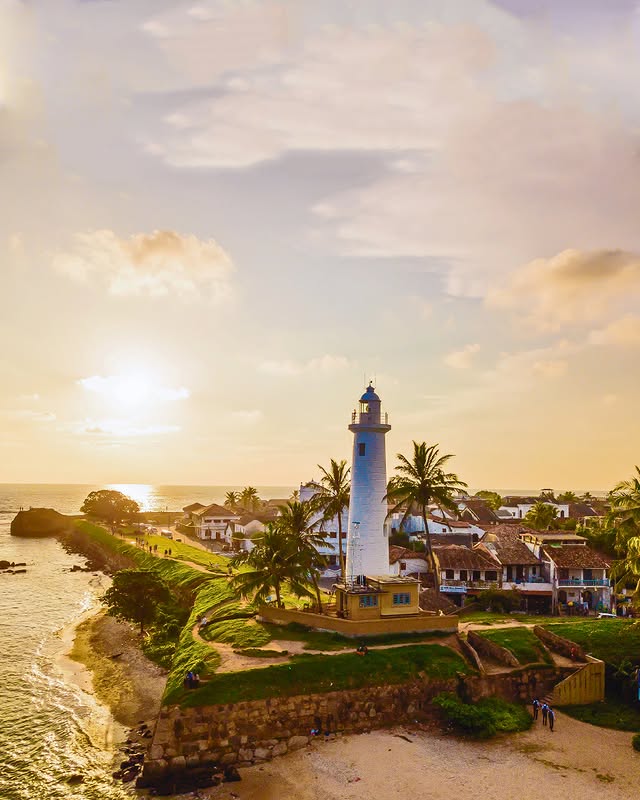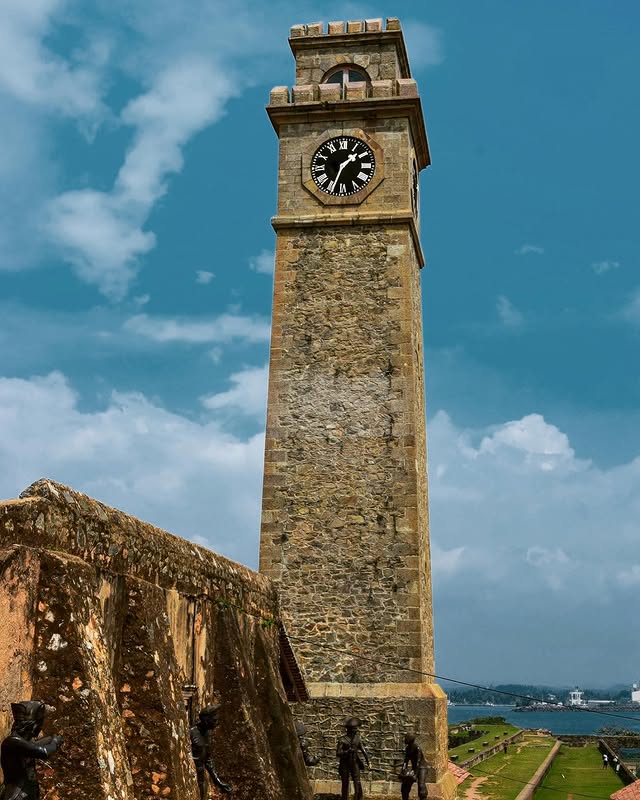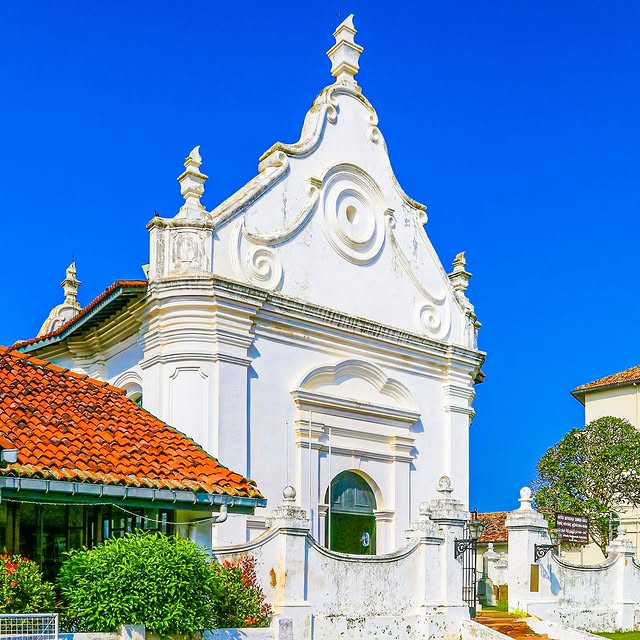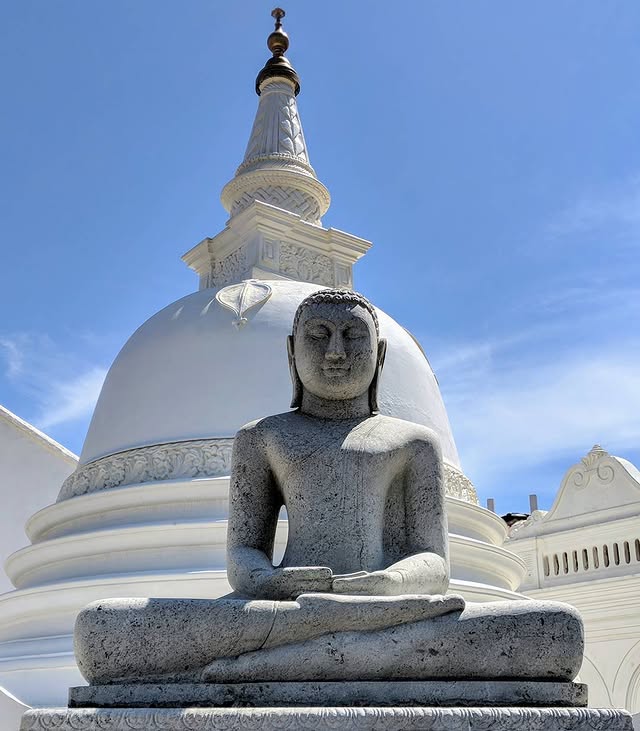Have you heard of Galle? It’s famous for the Galle Fort, a 16th-century colonial sea fortress and UNESCO World Heritage site.
The Portuguese originally built it, and later the Dutch and British added reinforcements. The architecture is incredibly well-preserved, and you can walk along cobblestone streets while taking in some stunning ocean views. It’s a must-see if you’re into history and beautiful scenery!
When you visit, you’ll find that the main languages spoken are Sinhala and Tamil, which are the official languages of Sri Lanka. But don’t worry if you don’t speak those languages- English is commonly spoken in the tourist areas, especially within Galle Fort. This makes it super easy to get around and communicate with locals.
Have you been thinking about visiting Galle? Must visit it as it tops the list of the best places to visit in Sri Lanka. So, you must include it in your Sri Lanka itinerary.
Galle Dutch Fort
Galle Dutch Fort shares a fascinating story through the photos and captions of every traveller.
| Highlight: It is a UNESCO World Heritage Site. |
The Portuguese built the fort in the 16th century during their conquests. In the 17th century, the Dutch gained control, and later, the British took over. For over 200 years, Galle served as a trading port for spices and other goods. Today, the fort is a beautiful historical site where visitors can explore its rich history.
The fort combines European architectural styles with local Sri Lankan elements, such as coral stone walls, watchtowers, and thick fortifications. Inside the fort, you can find old Dutch colonial buildings, churches, museums, and residential homes.

Fifty Lighthouse Street is a great place to stay when exploring Galle. The fort keeps its original charm. You can walk along the ramparts to see landmarks like-
- The Galle Lighthouse
- Galle Clocktower
- Groote Kerk
Galle Fort shows the history of Sri Lanka during colonial rule. And today, the fort is a lively area with cafes, art galleries, boutique hotels, and shops. So, must visit this place in Galle.
Galle Lighthouse
The 1st lighthouse in Sri Lanka.
Galle Lighthouse, built in the mid-1800s, is the oldest lighthouse in Sri Lanka. It is situated within Galle Fort, an important historical site.
It was built by the British in 1848. It was 24.5 meters tall and helped ships see the harbour. A fire burned down the old lighthouse in 1934. A new one was built in 1939, and it is taller, at 26.5 metres, and located about 100 metres away from the old one.
The Galle Lighthouse continues to serve its purpose as a navigational aid for ships. The light from the lighthouse is visible from several miles offshore, helping vessels safely navigate around the coastline. It also plays a key role in Sri Lanka’s maritime safety.
The lighthouse is located in a public area, so while you can’t enter the place itself (as it is still operational), visitors are welcome to enjoy the views from the surrounding area.
Maritime Museum
The National Maritime Archaeology Museum is situated in Galle, Sri Lanka, and is a significant cultural site. Housed in a Dutch warehouse built in 1671, the museum is located near the Old Gate of Galle Fort. It presents Sri Lanka’s rich maritime history to visitors.
The building showcases colonial architecture and is the longest Dutch building in Southeast Asia, featuring a 130-metre-long outer wall. Over the centuries, it has served different roles, including a warehouse and an office complex. In 1992, it was turned into a museum.
The museum has four main galleries:
- Gallery 1: An introduction to Maritime Archaeology.
- Gallery 2: Sri Lanka’s trade relations with other countries throughout different time periods.
- Gallery 3: Social and cultural changes in Sri Lanka from the 17th to 19th centuries.
- Gallery 4: Artefacts from the Dutch merchant ship Avondster, which sank in Galle harbour.
Galle Fort Clock Tower
The Galle Fort Clock Tower was built in 1883 by a wealthy man named Don Julius de Lanerolle. He was a Sri Lankan of European descent and wanted to give this tower as a gift to the people of Galle.

It was constructed in memory of his father, who was respected in the community. At first, the clock tower also served as a lighthouse, helping ships navigate into the harbour. Later, the current Galle Lighthouse took over this duty.
The clock tower is three stories tall, featuring a stone and brick neo-Gothic design. Its narrow rectangular shape is topped with a small dome, and it has a large clock face on the upper level, visible from afar. The clock mechanism, imported from the UK, still works today, keeping time for visitors to the fort.
Why is it Popular?
The Galle Fort Clock is a popular photo spot for tourists, for its picturesque setting along the fort’s ramparts and the stunning ocean view that surrounds it.
Note: You can’t enter the clock tower itself, but you can stop and admire the tower from outside.
Dutch Reformed Church
The Dutch Reformed Church, also called De Groote Kerk, is the oldest Protestant church in Sri Lanka. It is located in Galle Fort, which is a UNESCO World Heritage Site known for its well-preserved colonial buildings.

It was built in 1755. The Dutch Reformed Church features neoclassical architectural elements, such as whitewashed walls, simple lines, and large wooden beams that support the ceiling.
The church’s historic graveyard has many tombs of Dutch and European officials. Some of these officials played important roles in managing the Dutch colony in Ceylon, now known as Sri Lanka.
Japanese Peace Pagoda – Rumassala
Have you ever seen the Japanese Peace Pagoda in Galle? It’s such an enchanting sight! The stupa is this beautiful white dome shape, and it’s decorated with golden Buddha statues. It really gives off a vibe of simplicity and peace.
In 1947, Nichidatsu Fujii, a Japanese Buddhist monk, committed himself to building Peace Pagodas as symbols of peace. He has built more than 80 of these pagodas around the world, including in Europe, Asia, and the United States.

One of these is the Japanese Peace Pagoda, also called Sama Cetiya. It is a peaceful Buddhist monument located on Rumassala Hill near Unawatuna, Sri Lanka.
The structure was built in 2005 with help from Japanese Buddhist monks. It symbolises peace and harmony. It existed because of the ideas of Nichidatsu Fujii, the founder of the Nipponzan-Myōhōji Buddhist Order.
National Museum Galle
The National Museum of Galle is an important cultural place in Galle Fort, southern Sri Lanka. It is located in the oldest Dutch building in the fort, built in 1656 as a storage facility. The museum opened to the public on March 31, 1986.

Exhibits & Galleries: The museum has three main galleries,
- Traditional Cottage Industries:This gallery showcases local crafts such as turtle-shell jewellery, Beeralu lace weaving, and carving of traditional wooden masks.
- Colonial Artefacts: This exhibit displays items from the Portuguese, Dutch, and British periods, including coins, period furniture, weapons, and costumes.
- Sri Lanka-China Friendship Gallery: This gallery focuses on trade relations between Sri Lanka and China. It includes displays about the Chinese Buddhist monk Faxian and the 15th-century fleet admiral Zheng He.
The museum is housed in a historic building with various past uses. It originally served as a Dutch commissariat store.
The building became a billiards room for the New Oriental Hotel, now the Amangalla Hotel. Today, it houses a museum showcasing the Galle region’s cultural heritage and serves as an educational centre for locals and visitors.
The Dutch Hospital Shopping Precinct
The Dutch built the building as a hospital in 1681 to care for the officers and staff of the Dutch East India Company.
After independence, it became the Colombo Fort Police Station from the early 1980s to the 1990s and was previously the site of the Colombo Apothecaries.
In 2011, the Urban Development Authority turned it into a shopping and dining area while keeping its historic buildings.
The Dutch Hospital Shopping Precinct in Galle Fort is a beautifully restored colonial-era building that now serves as a lively centre for shopping, dining, and relaxation.
Architecturally, it reflects 17th-century Dutch colonial style with five wings and two courtyards, designed to stay cool and comfortable.
What’s there?
- Shops: Discover boutiques that sell traditional Sri Lankan handicrafts, jewellery, and souvenirs. So, buying some of the best things will be a great thing here.
- Cafes & Restaurants (from casual cafes to more upscale dining options).
- Spa & Wellness
The precinct’s two central courtyards often feature live music, adding to the vibrant atmosphere of Sri Lankan nightlife.
Flag Rock Bastion
Flag Rock Bastion is the southern tip of Galle Fort. It offers great views of the Indian Ocean and shows Sri Lanka’s colonial maritime history.
Flag Rock was built by the Portuguese in the 17th century and later strengthened by the Dutch. It served as a signal station for ships coming into Galle Harbour.
Dutch sailors used flags to warn other ships about dangerous underwater reefs. When visibility was low, they fired muskets from nearby Pigeon Island to alert ships of the dangers.
Flag Rock is a popular spot for watching the sunset at Galle Fort, located with the Galle Lighthouse to the west and historic landmarks to the east.
Street food vendors sell spiced fruit to visitors, while locals sometimes leap into the waters below. Rampart Street, which leads to Flag Rock, features several cafes with excellent sunset views.
Sri Sudharmalaya Buddhist Temple
Sri Sudharmalaya is a small Buddhist temple in Galle Fort. It is known for its peaceful atmosphere and the mix of architectural styles from different religions. The temple sits on a fort that looks out over the sea.

Highlights:
- A seated Buddha statue.
- The temple’s unique white-painted exterior and a small belfry suggest the building may have once been a church.
What’s inside?
- A mini stupa dating back to 1889.
- A large reclining Buddha statue.
- Several smaller Buddha statues.
- A prayer hall (used for yoga classes presently)
Social Recognition – In 2016, UN Secretary-General Ban Ki-moon visited and praised its multicultural harmony. Galle Fort is a rare example of peaceful interfaith coexistence.
Conclusion
Galle is an incredible destination where history, culture, and natural beauty converge. You can walk along the charming cobbled streets of Galle Fort, relax at Jungle Beach, or explore local heritage at the museums and temples.
Every part of this coastal gem has something unique to offer. Don’t miss the beautiful sunsets at Flag Rock and the lively vibe at the Dutch Hospital precinct.
Galle really invites you to enjoy a wonderful mix of the old and the new. It’s a spot that leaves you with lasting memories and a deeper love for Sri Lanka’s vibrant coastal life!
Frequently Asked Questions on the Best Places to Visit in Galle
What is the most popular attraction in Galle?
The Galle Fort, a UNESCO World Heritage Site, is the most famous landmark, known for its colonial architecture and ocean views.
Where can I enjoy the best sunset in Galle?
Head to the Flag Rock Bastion at the southern edge of Galle Fort for stunning sunset views over the ocean.
Is there a beach near Galle Fort?
Yes, Jungle Beach near Rumassala is a quiet spot ideal for swimming and snorkelling.
What are the must-visit cultural sites inside Galle Fort?
Don’t miss the Dutch Reformed Church, Sudharmalaya Temple, and Meeran Mosque, reflecting Galle’s diverse religious heritage.
Where can I shop or dine in Galle Fort?
The Dutch Hospital Shopping Precinct offers boutique stores and restaurants in a beautiful colonial building.
Is there a museum in Galle Fort?
Yes, the National Museum of Galle and the Maritime Archaeology Museum showcase colonial and seafaring history.
Is the Galle Lighthouse worth visiting?
Absolutely! The Galle Lighthouse is iconic, photogenic, and located along the Fort’s scenic ramparts.